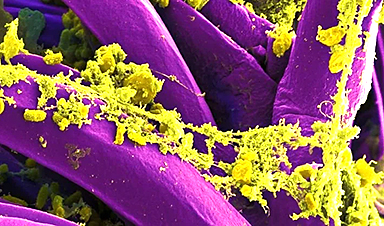Thousands of years ago, across the Eastern Mediterranean, multiple Bronze Age civilizations took a distinct turn for the worse at around the same time.
The Old Kingdom of Egypt and the Akkadian Empire both collapsed, and there was a widespread societal crisis across the Ancient Near East and the Aegean, manifesting as declining populations, destruction, reduced trade, and significant cultural changes.
In remains excavated from an ancient burial site on Crete, in a cave called Hagios Charalambos, a team led by archaeogeneticist Gunnar Neumann of the Max Planck Institute for Evolutionary Anthropology in Germany found genetic evidence of bacteria responsible for two of history’s most significant diseases – typhoid fever and plague.
Therefore, the researchers said, widespread illnesses caused by these pathogens cannot be discounted as a contributing factor in the societal changes so widespread around 2200 to 2000 BCE.
“The occurrence of these two virulent pathogens at the end of the Early Minoan period in Crete,” they wrote in their paper, “emphasizes the necessity to re-introduce infectious diseases as an additional factor possibly contributing to the transformation of early complex societies in the Aegean and beyond.”
Yersinia pestis is a bacterium responsible for tens of millions of deaths, most occurring in the course of three devastating global pandemics. Catastrophic as this disease was in centuries gone by, its impact prior to the Plague of Justinian, which started in 541 CE, has been difficult to gauge.
We now suspect, for example, that the bacterium has been infecting people since at least the Neolithic period.
Last year, scientists revealed that a Stone Age hunter-gatherer likely died of plague thousands of years before we had evidence of the disease reaching epidemic proportions.
However, the genomic evidence recovered had so far been from colder regions. Little is known about its impact on ancient societies in warmer climates, such as those in the Eastern Mediterranean, thanks to the degradation of DNA in the higher temperatures.
So Neumann and his team went digging through bones recovered from a site on Crete known for its remarkably cool and stable conditions.
They recovered DNA in teeth from 32 individuals who died between 2290 and 1909 BCE. The genetic data revealed the presence of quite a few common oral bacteria, which was expected.
Less expected was the presence of Y. pestis in two individuals and two Salmonella enterica lineages – a bacterium typically responsible for typhoid fever – in two others. This discovery suggests that both pathogens were present and possibly transmissible in Bronze Age Crete.
The lineage of Y. pestis they uncovered probably couldn’t be transmitted through fleas – one of the traits that made other lineages of the bacterium so contagious in human populations.
The flea vector carries the bubonic version of the plague; humans become infected when the bacterium enters the lymphatic system via a flea bite. Therefore, the transmission route of this ancient form of the bacterium could be different and cause a different form of plague; pneumonic plague, which is transmitted via aerosols, for example.
The researchers said that the S. enterica lineages also lacked key traits that contribute to severe disease in humans, so the virulence and transmission routes of both pathogens remain unknown.
Nevertheless, the discovery suggests that both pathogens were circulating; in regions of Crete with high population densities, they could have run somewhat rampant.
“While it is unlikely that Y. pestis or S. enterica were the sole culprits responsible for the societal changes observed in the Mediterranean at the end of the 3rd millennium BCE,” the researchers wrote in their paper, “we propose that, given the [ancient] DNA evidence presented here, infectious diseases should be considered as an additional contributing factor; possibly in an interplay with climate and migration, which has been previously suggested.”
Because diseases like plague and typhoid do not leave traces on bones, they are not frequently noticed in the archaeological record. The team suggests that more detailed genetic screening of more remains from the Eastern Mediterranean could help uncover the extent of the impact these diseases had on the civilizations who lived there.
News
Lower doses of immunotherapy for skin cancer give better results, study suggests
According to a new study, lower doses of approved immunotherapy for malignant melanoma can give better results against tumors, while reducing side effects. This is reported by researchers at Karolinska Institutet in the Journal of the National [...]
Researchers highlight five pathways through which microplastics can harm the brain
Microplastics could be fueling neurodegenerative diseases like Alzheimer's and Parkinson's, with a new study highlighting five ways microplastics can trigger inflammation and damage in the brain. More than 57 million people live with dementia, [...]
Tiny Metal Nanodots Obliterate Cancer Cells While Largely Sparing Healthy Tissue
Scientists have developed tiny metal-oxide particles that push cancer cells past their stress limits while sparing healthy tissue. An international team led by RMIT University has developed tiny particles called nanodots, crafted from a metallic compound, [...]
Gold Nanoclusters Could Supercharge Quantum Computers
Researchers found that gold “super atoms” can behave like the atoms in top-tier quantum systems—only far easier to scale. These tiny clusters can be customized at the molecular level, offering a powerful, tunable foundation [...]
A single shot of HPV vaccine may be enough to fight cervical cancer, study finds
WASHINGTON -- A single HPV vaccination appears just as effective as two doses at preventing the viral infection that causes cervical cancer, researchers reported Wednesday. HPV, or human papillomavirus, is very common and spread [...]
New technique overcomes technological barrier in 3D brain imaging
Scientists at the Swiss Light Source SLS have succeeded in mapping a piece of brain tissue in 3D at unprecedented resolution using X-rays, non-destructively. The breakthrough overcomes a long-standing technological barrier that had limited [...]
Scientists Uncover Hidden Blood Pattern in Long COVID
Researchers found persistent microclot and NET structures in Long COVID blood that may explain long-lasting symptoms. Researchers examining Long COVID have identified a structural connection between circulating microclots and neutrophil extracellular traps (NETs). The [...]
This Cellular Trick Helps Cancer Spread, but Could Also Stop It
Groups of normal cbiells can sense far into their surroundings, helping explain cancer cell migration. Understanding this ability could lead to new ways to limit tumor spread. The tale of the princess and the [...]
New mRNA therapy targets drug-resistant pneumonia
Bacteria that multiply on surfaces are a major headache in health care when they gain a foothold on, for example, implants or in catheters. Researchers at Chalmers University of Technology in Sweden have found [...]
Current Heart Health Guidelines Are Failing To Catch a Deadly Genetic Killer
New research reveals that standard screening misses most people with a common inherited cholesterol disorder. A Mayo Clinic study reports that current genetic screening guidelines overlook most people who have familial hypercholesterolemia, an inherited disorder that [...]
Scientists Identify the Evolutionary “Purpose” of Consciousness
Summary: Researchers at Ruhr University Bochum explore why consciousness evolved and why different species developed it in distinct ways. By comparing humans with birds, they show that complex awareness may arise through different neural architectures yet [...]
Novel mRNA therapy curbs antibiotic-resistant infections in preclinical lung models
Researchers at the Icahn School of Medicine at Mount Sinai and collaborators have reported early success with a novel mRNA-based therapy designed to combat antibiotic-resistant bacteria. The findings, published in Nature Biotechnology, show that in [...]
New skin-permeable polymer delivers insulin without needles
A breakthrough zwitterionic polymer slips through the skin’s toughest barriers, carrying insulin deep into tissue and normalizing blood sugar, offering patients a painless alternative to daily injections. A recent study published in the journal Nature examines [...]
Multifunctional Nanogels: A Breakthrough in Antibacterial Strategies
Antibiotic resistance is a growing concern - from human health to crop survival. A new study successfully uses nanogels to target and almost entirely inhibit the bacteria P. Aeruginosa. Recently published in Angewandte Chemie, the study [...]
Nanoflowers rejuvenate old and damaged human cells by replacing their mitochondria
Biomedical researchers at Texas A&M University may have discovered a way to stop or even reverse the decline of cellular energy production—a finding that could have revolutionary effects across medicine. Dr. Akhilesh K. Gaharwar [...]
The Stunning New Push to Protect the Invisible 99% of Life
Scientists worldwide have joined forces to build the first-ever roadmap for conserving Earth’s vast invisible majority—microbes. Their new IUCN Specialist Group reframes conservation by elevating microbial life to the same urgency as plants and [...]





















